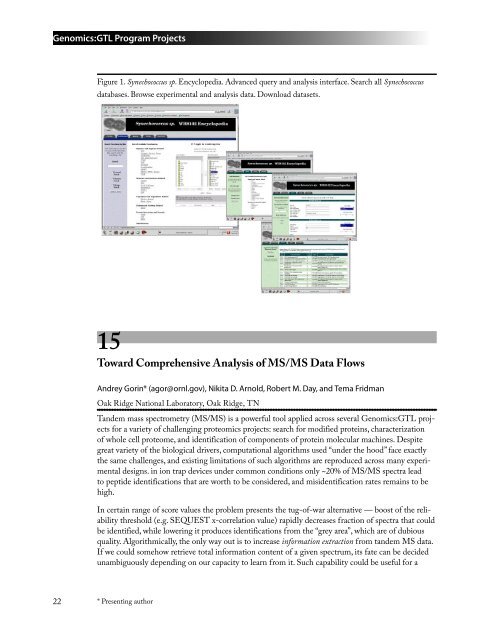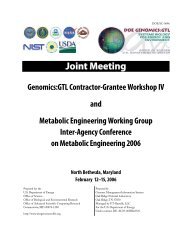2005 gtl abstracts.indb - Genomics - U.S. Department of Energy
2005 gtl abstracts.indb - Genomics - U.S. Department of Energy
2005 gtl abstracts.indb - Genomics - U.S. Department of Energy
Create successful ePaper yourself
Turn your PDF publications into a flip-book with our unique Google optimized e-Paper software.
<strong>Genomics</strong>:GTL Program Projects<br />
Figure 1. Synechococcus sp. Encyclopedia. Advanced query and analysis interface. Search all Synechococcus<br />
databases. Browse experimental and analysis data. Download datasets.<br />
15<br />
Toward Comprehensive Analysis <strong>of</strong> MS/MS Data Flows<br />
Andrey Gorin* (agor@ornl.gov), Nikita D. Arnold, Robert M. Day, and Tema Fridman<br />
Oak Ridge National Laboratory, Oak Ridge, TN<br />
Tandem mass spectrometry (MS/MS) is a powerful tool applied across several <strong>Genomics</strong>:GTL projects<br />
for a variety <strong>of</strong> challenging proteomics projects: search for modified proteins, characterization<br />
<strong>of</strong> whole cell proteome, and identification <strong>of</strong> components <strong>of</strong> protein molecular machines. Despite<br />
great variety <strong>of</strong> the biological drivers, computational algorithms used “under the hood” face exactly<br />
the same challenges, and existing limitations <strong>of</strong> such algorithms are reproduced across many experimental<br />
designs. in ion trap devices under common conditions only ~20% <strong>of</strong> MS/MS spectra lead<br />
to peptide identifications that are worth to be considered, and misidentification rates remains to be<br />
high.<br />
In certain range <strong>of</strong> score values the problem presents the tug-<strong>of</strong>-war alternative — boost <strong>of</strong> the reliability<br />
threshold (e.g. SEQUEST x-correlation value) rapidly decreases fraction <strong>of</strong> spectra that could<br />
be identified, while lowering it produces identifications from the “grey area”, which are <strong>of</strong> dubious<br />
quality. Algorithmically, the only way out is to increase information extraction from tandem MS data.<br />
If we could somehow retrieve total information content <strong>of</strong> a given spectrum, its fate can be decided<br />
unambiguously depending on our capacity to learn from it. Such capability could be useful for a<br />
22 * Presenting author





